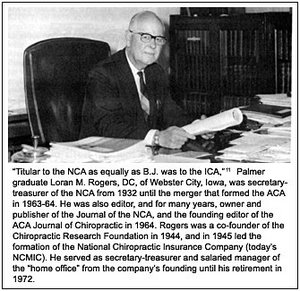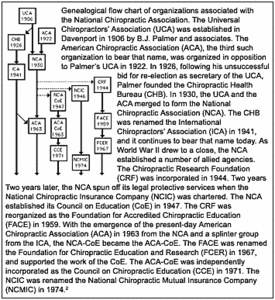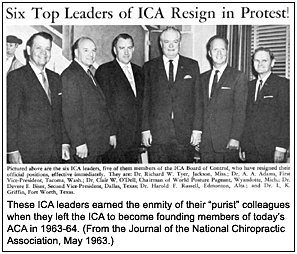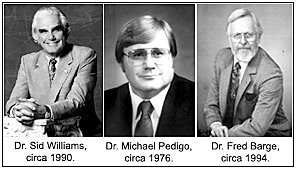During the difficult days of the Great Depression, the National Chiropractic Association (NCA) struggled for membership. In the wake of World War II, however, as veterans returned and chiropractic colleges saw a dramatic increase in enrollment, a new confidence took hold within organized chiropractic; it took a number of giant steps in its infrastructure during this period. The Chiropractic Research Foundation (CRF; today's FCER) was established by the NCA as a nonprofit philanthropic agency in 1944,13 and would fund NCA and later ACA projects (especially college improvements) for decades. Two years later, the NCA board of directors established the Mutual Corporation for Malpractice Insurance, today the National Chiropractic Mutual Insurance Company (NCMIC). Of interest in this regard was the NCMIC's first legal team, who were members of the Wisconsin law firm descended from Tom Morris and the legal defenders of Dr. Shegetaro Morikubo in 1907.2 Profits from the malpractice insurer, which might otherwise have been returned to policyholders as dividends, were donated to the CRF for its grant-making activities.
Following Dr. B.J. Palmer's death in 1961, it was hoped that greater unity in the profession would be possible. The NCA and ICA had been feuding for years over issues of scope of practice, and length and content of chiropractic education.14 Now, it seemed possible to combine forces in common purpose. Adding to the optimism for unity was the success experienced in forming the NBCE in 1962-63, through cooperative efforts of the "straights" and "mixers" comprising the COSCEB. Overtures to the new leadership of Palmer's ICA were made, but were only partly successful.15,16 A splinter group from the ICA leadership worked with NCA leaders to establish the ACA "master plan" for the profession. The new ACA became reality in January 1964, but its constitution and bylaws were rewritten by the state delegates at the organization's first convention in Denver later that year. Specifically rejected was a clause that would have specified a scope of practice, replaced by a "states' rights" policy that left such issues to individual states.
The new ACA and the ICA continued to spar with one another, with each national society supporting a different accrediting body for chiropractic schools. The competing applications for recognition by the U.S. Office of Education (USOE), from the ACA-endorsed CCE and the ICA-endorsed Association of Chiropractic Colleges (ACC; not related to today's ACC) undoubtedly delayed recognition of chiropractic education at the federal level. The CCE achieved federal recognition as an accrediting body for chiropractic colleges in August 1974;14 once this was established, most chiropractic schools promptly sought accreditation through CCE. The various licensing boards around the nation gradually accepted CCE accreditation in lieu of their own school evaluations, and the agency became a source of pride and unified action in subsequent years. However, the CCE authority was challenged in the 1980s when the Straight Chiropractic Academic Standards Association (SCASA) was briefly recognized by USOE.
Additional efforts to generate a single, unified national membership society of chiropractors have been undertaken in the past 40 years, most notably in the late 1980s. At that time, Michael Pedigo, DC (co-plaintiff in the Wilk antitrust suit against the American Medical Association and affiliated allopathic organizations), was elected president of the ICA. Dr. Pedigo sought an accommodation with the ACA, and nearly succeeded in bringing about a merger of the two groups. However, this initiative was opposed by former ICA president and board chairman, Sid E. Williams, DC, founder and president of Life Chiropractic College of Marietta, Georgia. In 1988, a vote among ICA members on the merger failed to reach the two-thirds majority required by their articles of incorporation, and the effort failed.
The late Fred Barge, DC, PhC, succeeded Dr. Pedigo as president of the ICA and fostered a re-commitment to "Palmer principles" within the organization. Dr. Pedigo joined the ACA and eventually served as CEO of that organization; he is the only individual to have served as president of both societies. Since 1993, Dr. Pedigo has been a member of the board of directors of the NCMIC.
The story of organized chiropractic has yet to be told in all its detail. In particular, the eight-decade story of the ICA has received only brief review,17 and the past 40 years of the ACA saga have yet to be told. A few states have published works on the history of chiropractic in their jurisdictions,18-20 and the late Martha Metz, DC, wrote and published a history of the profession in Kansas some years ago.21 The sagas of the COSCEB FCLB and the NCMIC will soon become available through the publication of two books dealing with their histories. Tales of organized chiropractic beyond American borders also await a full accounting.
As the profession nears this centennial milestone of organized chiropractic, now may be a good time to take stock of how its infrastructure has evolved. While the past provides no blueprint of the future, understanding the lessons of yesteryear can aid in avoiding pitfalls and in facilitating more prudent planning. "Those who forget their past," it has been suggested, "may be doomed to repeat it."
References
- Keating, Joseph C. The short life and enduring influence of the American Chiropractic Association, 1922-1930. Chiropractic History 1996 (June);16(1):50-64.
- Keating, Joseph C. Roots of the NCMIC: Loran M. Rogers & the National Chiropractic Association, 1930-1946. Chiropractic History 2000 (June);20(1):39-55.
- Gielow, Vern. Old Dad Chiro: a Biography of D.D. Palmer, Founder of Chiropractic. Davenport, Iowa: Bawden Brothers, 1981.
- Gibbons, Russell W. Minnesota, 1905: Who killed the first chiropractic legislation? Chiropractic History 1993 (June);13(1):26-32.
- Keating JC. Birth of the National Board of Chiropractic Examiners. Journal of Chiropractic Education 2003b (Fall);17(2):89-104.
- Rehm, William S. Who was who in chiropractic: a necrology. In Dzaman, Fern, et al. (eds.) Who's Who in Chiropractic, International, second edition. Littleton Colo.: Who's Who in Chiropractic International Publishing Co., 1980, pp. 322-3.
- Keating, Joseph C. B.J. of Davenport: The Early Years of Chiropractic. Davenport, Iowa: Association for the History of Chiropractic, 1997.
- Margetts, Frank R. Does chiropractic need a saviour? Bulletin of the American Chiropractic Association 1924 (Sept);1(4):1.
- Keating, Joseph C. Introducing the neurocalometer: a view from the Fountain Head. Journal of the Canadian Chiropractic Association 1991 (Sept);35(3):165-78.
- Keating, Joseph C. Before Nugent took charge: early efforts to reform chiropractic education, 1919-1941. Journal of the Canadian Chiropractic Association 2003a (Sept);47 (3):180-216.
- Gibbons, Russell W. Chiropractic's Abraham Flexner: the lonely journey of John J. Nugent, 1935-1963. Chiropractic History 1985;5:44-51.
- Keating, Joseph C. and Rehm, William S. The origins and early history of the National Chiropractic Association. Journal of the Canadian Chiropractic Association 1993 (Mar);37(1):27-51.
- Keating, Joseph C.; Green, Bart N.; Johnson, Claire D. "Research" and "science" in the first half of the chiropractic century. Journal of Manipulative & Physiological Therapeutics 1995 (July/Aug);18(6):357-78.
- Keating, Joseph C.; Callender, Alana K.; Cleveland, Carl S. A History of Chiropractic Education in North America: Report to the Council on Chiropractic Education. Davenport, Iowa: Association for the History of Chiropractic, 1998.
- Griffin, Leonard K. Merger almost: ICA unity efforts and formation of the American Chiropractic Association. Chiropractic History 1988 (Dec);8(2):18-22.
- Plamondon, Ronald L. Mainstreaming chiropractic: tracing the American Chiropractic Association. Chiropractic History 1993 (Dec);13(2):30-5.
- Gibbons, Russell W. Vision to action: a history of ICA: the first 60 years. ICA Review 1986 Mar/Apr);42(2):33-64 (Supplement).
- Mawhiney, Robert B. Chiropractic in Wisconsin, 1900-1950. Madison Wisc.: Wisconsin Chiropractic Association, 1984.
- McGinnis, Edward J. and Jordan, Jordan. (eds.): A History of Chiropractic in South Carolina. South Carolina Chiropractic Association, 1997.
- Rhodes, Walter R. The Official History of Chiropractic in Texas. Austin, Texas: Texas Chiropractic Association, 1978.
- Metz M. Fifty Years of Chiropractic Recognized in Kansas. Abilene, Kan., 1965.
Joseph Keating Jr., PhD
Phoenix Arizona
Click here for previous articles by Joseph Keating Jr., PhD.









